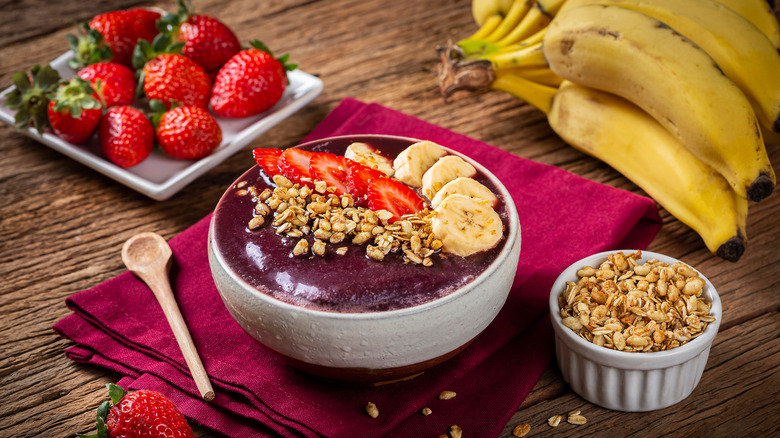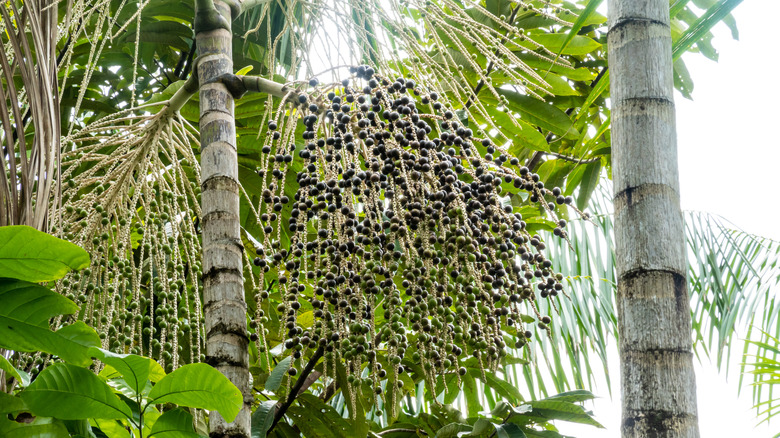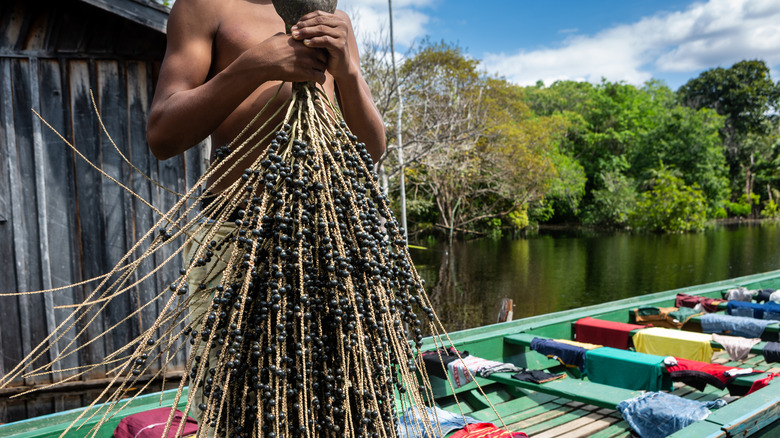The Acai Industry Has A Serious Child Labor Problem
Next time you devour the acai berries in your granola bowl, you might consider what's really involved in their journey from the jungles of Brazil all the way to your spoon. Due to their delicious taste and perceived health benefits, acai berries have become a coveted food item for Americans, and one does not need to search very hard to find them in most health food restaurants and smoothie shops. Reportedly one of the most antioxidant-rich fruits, acai counters the negative effects of free radicals, which helps to prevent things like cancer, diabetes, and heart disease (via Healthline). The U.S. has now become the biggest consumer market of acai outside of Brazil and is expected to hit $2 billion in revenue by 2026 (per The Washington Post).
According to the U.S. Department of Labor, Brazil leads the world in not only the production of acai — it's also a leader in violations of child labor laws in the acai industry. Despite international standards set by the Bureau of International Labor Affairs (ILAB), child labor violations involving the acai production in the Amazon continue to make for a disturbing reality.
Why is this happening?
Acai trees grow in various parts of Central and South America along the Amazon River, but we see their greatest presence in Brazil (via Britannica). It is the children in the indigenous communities who serve as the labor force behind the production of acai (per The Washington Post). Acai trees are very thin and can snap under the weight of an adult, so it is the children who end up scaling trees that can reach heights of 80 feet, in order to pick the acai berries for processing. The Washington Post detailed the dangers inflicted on children who do the harvesting — according to their research, children from poor rural areas were harvesting acai by climbing the palm trees in the jungle and were subjected to accidents caused by falling from trees and being poisoned by snakes and spiders, with reports of death and paralyzing injuries.
It is considered one of the most dangerous jobs in Brazil — there are even reports of children disappearing in the rainforest (via The Washington Post). Despite this treacherous labor, the farmers receive very little compensation. According to Forbes, a basket of berries only earns a family about $3. While U.S. consumers are willing to pay $15 dollars for an acai smoothie, the laborers remain trapped in extreme poverty, or as The Washington Post describes it, "toiling on the bottom rung of an industry that connects some of Brazil's poorest people to America's health-absorbed elite."
Is anything being done to solve this problem?
As recently as 2021, Brazil made some small efforts to eliminate child labor by publishing what was called a "dirty list" of employers using this practice; however with few labor inspectors, it is nearly impossible for local areas follow through with action (via U.S. Department of Labor). While there have been efforts through organizations like Fair for Life to rid (or at least reduce) child labor from acai production, it appears to be mostly ineffective. According to Manoel Potiguar, co-author of the labor tribunal study, there's "a 90 percent chance that the acai being eaten by someone in the United States was produced in an unjust way."
Sombazon is an acai company in the U.S. trying to lead the way in stopping the use of child labor. However, without companies being willing to subsidize local farmers more, families will feel forced to use their children to survive (per The Washington Post). And with the acai supply chain involving thousands of families who live across vast territories, it would be extremely hard to control or monitor any international standards for child labor. In the meantime, Americans who crave acai will need to think twice about the industry they are helping to fuel.


